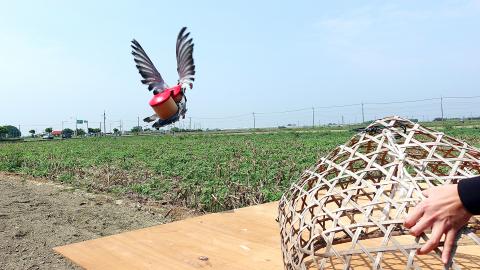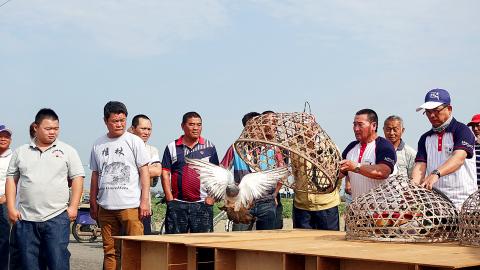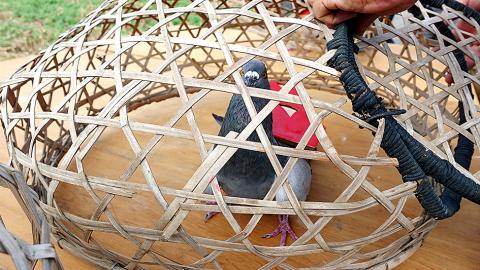Aman surnamed Tsai (蔡) carefully attaches a wooden bell onto the tail of his pigeon before carrying it to the starting line. Fourteen of his pigeons will fly today, many of them for two or three rounds, he says.
With clear skies and favorable wind, the pigeon whistle race (賽鴿笭) began on Sunday at 8am between Sinfu Village (新富) and Touchu Village (頭竹) in Yijhu Township (義竹), Chiayi County.
“There are less people raising pigeons these days because it requires a lot of time and money. Our races used to be much larger,” Tsai says.

Photo Courtesy of Lin Ting-chun
Sunday’s race was the second leg of a month-long tournament between eight villages in Yijhu. Organized by the Chiayi County Cultural Foundation (嘉義縣文化基金會), the Chiayi Yijhu Pigeon Whistle Culture Festival (嘉義義竹鴿笭文化季), recognizes pigeon whistle racing as an representative heritage of the Chiayi region.
During the opening ceremony on Thursday last week, Chiayi County commissioner Weng Chang-liang (翁章梁) recounted his memories of attending the pigeon races as a child.
“People watched the skies, following the pigeons so intently that they would lose their footing,” Weng said. “Through this festival we hope to bring more people to Yijhu for a special experience of Taiwanese rural life.”

Photo Courtesy of Lin Ting-chun
HISTORICAL EVENT
Pigeon whistle racing is a Taiwanese folk tradition that has thrived on the border of Chiayi and Tainan for over 100 years.
Its pedigree, however, dates back much earlier. During the Ming Dynasty, under the rule of Koxinga, also known as Cheng Cheng-kung (鄭成功), soldiers stationed in what is now Tainan’s Sinying (新營區) and Yanshuei (鹽水區) districts would place whistles on the backs of messenger pigeons to amuse themselves with the sound the whistles create when the birds are in flight.

Photo Courtesy of Lin Ting-chun
The activity eventually grew into an annual folk competition — one that the Tainan City government also organizes in a contest between Yanshuei (鹽水), Syuechia (學甲) and Sinying districts.
The birds start learning to fly after one month of birth and athletic performance typically peaks at ages three to five.
“The pigeons used in our races are three times larger than average race pigeons,” says Sinfu Village Chief Lin fu-chuan (林福傳). “They need to be large enough to carry the whistles.”
Lin has been keeping pigeons for over twenty years.
“I caught the bug from my grandfather,” he says.
In consideration of his aging parents and his passion for pigeon racing, Lin sold his residence in Taipei and in 2000 moved back to Sinfu Village.
Fellow pigeon keeper Yang Chi-chin (楊智欽) also has a similar experience of moving back to Sinfu after many years working in Sinying Township in the steel industry. At age 36, Yang is the youngest pigeon racer in today’s competition.
Weight training begins with small whistles (2-3 inches) and slowly increases to the standard competition size of 18cm to 23cm wide. The larger the whistle, the more air enters the whistle drum when the bird is in flight, which increases the weight of the whistle and makes flying more challenging.
During the race, one villages’ birds are brought to the opponent’s village, from which they carry as many whistles home as possible in a four-hour timeframe. The larger the whistle, the greater the points granted. A cumulative score is tallied at the end, and the winning village is rewarded by treating the losing village to an outdoor banquet.
The passion for pigeon racing is felt through the often tense atmosphere at the race, intermingled with the joy of team camaraderie and cheerful village onlookers on the sidelines.
Indeed, the intensity of the competition is encapsulated in a local saying: “It is okay for a man to lose in his career, but to lose in a pigeon bell race means losing face and dignity.”
The full tournament schedule is available online at www.cyhgcf.org.tw. Competition times may vary according to weather conditions.

This month the government ordered a one-year block of Xiaohongshu (小紅書) or Rednote, a Chinese social media platform with more than 3 million users in Taiwan. The government pointed to widespread fraud activity on the platform, along with cybersecurity failures. Officials said that they had reached out to the company and asked it to change. However, they received no response. The pro-China parties, the Chinese Nationalist Party (KMT) and Taiwan People’s Party (TPP), immediately swung into action, denouncing the ban as an attack on free speech. This “free speech” claim was then echoed by the People’s Republic of China (PRC),

Exceptions to the rule are sometimes revealing. For a brief few years, there was an emerging ideological split between the Democratic Progressive Party (DPP) and Chinese Nationalist Party (KMT) that appeared to be pushing the DPP in a direction that would be considered more liberal, and the KMT more conservative. In the previous column, “The KMT-DPP’s bureaucrat-led developmental state” (Dec. 11, page 12), we examined how Taiwan’s democratic system developed, and how both the two main parties largely accepted a similar consensus on how Taiwan should be run domestically and did not split along the left-right lines more familiar in

Specialty sandwiches loaded with the contents of an entire charcuterie board, overflowing with sauces, creams and all manner of creative add-ons, is perhaps one of the biggest global food trends of this year. From London to New York, lines form down the block for mortadella, burrata, pistachio and more stuffed between slices of fresh sourdough, rye or focaccia. To try the trend in Taipei, Munchies Mafia is for sure the spot — could this be the best sandwich in town? Carlos from Spain and Sergio from Mexico opened this spot just seven months ago. The two met working in the

Many people in Taiwan first learned about universal basic income (UBI) — the idea that the government should provide regular, no-strings-attached payments to each citizen — in 2019. While seeking the Democratic nomination for the 2020 US presidential election, Andrew Yang, a politician of Taiwanese descent, said that, if elected, he’d institute a UBI of US$1,000 per month to “get the economic boot off of people’s throats, allowing them to lift their heads up, breathe, and get excited for the future.” His campaign petered out, but the concept of UBI hasn’t gone away. Throughout the industrialized world, there are fears that